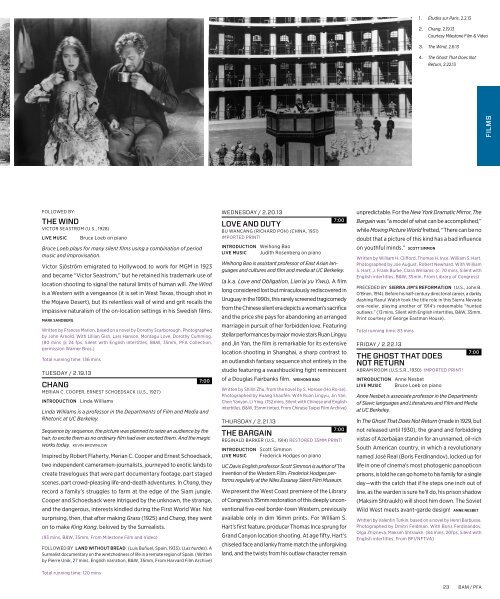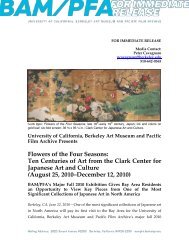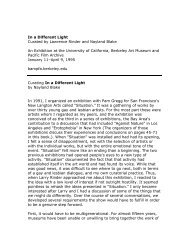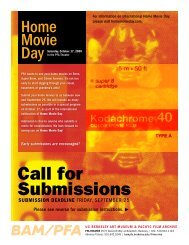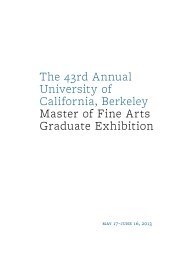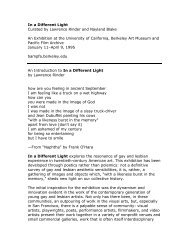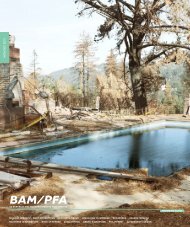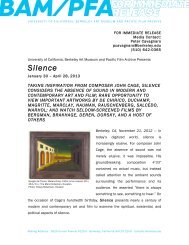January & February 2013 - Berkeley Art Museum and Pacific Film ...
January & February 2013 - Berkeley Art Museum and Pacific Film ...
January & February 2013 - Berkeley Art Museum and Pacific Film ...
- No tags were found...
Create successful ePaper yourself
Turn your PDF publications into a flip-book with our unique Google optimized e-Paper software.
1. Études sur Paris, 2.2.132. Chang, 2.19.13Courtesy Milestone <strong>Film</strong> & Video3. The Wind, 2.6.134. The Ghost That Does NotReturn, 2.22.13FILMSFollowed by:The WindVictor Seastrom (U.S., 1928)Live MusicBruce Loeb on pianoBruce Loeb plays for many silent films using a combination of periodmusic <strong>and</strong> improvisation.Victor Sjöström emigrated to Hollywood to work for MGM in 1923<strong>and</strong> became “Victor Seastrom,” but he retained his trademark use oflocation shooting to signal the natural limits of human will. The Windis a Western with a vengeance (it is set in West Texas, though shot inthe Mojave Desert), but its relentless wall of wind <strong>and</strong> grit recalls theimpassive naturalism of the on-location settings in his Swedish films.Mark S<strong>and</strong>bergWritten by Frances Marion, based on a novel by Dorothy Scarborough. Photographedby John Arnold. With Lillian Gish, Lars Hanson, Montagu Love, Dorothy Cumming.(80 mins @ 24 fps, Silent with English intertitles, B&W, 35mm, PFA Collection,permission Warner Bros.)Total running time: 136 minsTuesday / 2.19.137:00ChangMerian C. Cooper, Ernest Schoedsack (U.S., 1927)Introduction Linda WilliamsLinda Williams is a professor in the Departments of <strong>Film</strong> <strong>and</strong> Media <strong>and</strong>Rhetoric at UC <strong>Berkeley</strong>.Sequence by sequence, the picture was planned to seize an audience by thehair, to excite them as no ordinary film had ever excited them. And the magicworks today. Kevin BrownlowInspired by Robert Flaherty, Merian C. Cooper <strong>and</strong> Ernest Schoedsack,two independent cameramen-journalists, journeyed to exotic l<strong>and</strong>s tocreate travelogues that were part documentary footage, part stagedscenes, part crowd-pleasing life-<strong>and</strong>-death adventures. In Chang, theyrecord a family’s struggles to farm at the edge of the Siam jungle.Cooper <strong>and</strong> Schoedsack were intrigued by the unknown, the strange,<strong>and</strong> the dangerous, interests kindled during the First World War. Notsurprising, then, that after making Grass (1925) <strong>and</strong> Chang, they wenton to make King Kong, beloved by the Surrealists.(93 mins, B&W, 35mm, From Milestone <strong>Film</strong> <strong>and</strong> Video)Followed by L<strong>and</strong> Without Bread (Luis Buñuel, Spain, 1933). (Las hurdes). ASurrealist documentary on the wretchedness of life in a remote region of Spain. (Writtenby Pierre Unik, 27 mins, English narration, B&W, 35mm, From Harvard <strong>Film</strong> Archive)Total running time: 120 minsWednesday / 2.20.13Love <strong>and</strong> DutyBu Wancang (Richard Poh) (China, 1931)Imported Print!7:00Introduction Weihong BaoLive Music Judith Rosenberg on pianoWeihong Bao is assistant professor of East Asian languages<strong>and</strong> cultures <strong>and</strong> film <strong>and</strong> media at UC <strong>Berkeley</strong>.(a.k.a. Love <strong>and</strong> Obligation, Lian’ai yu Yiwu). A filmlong considered lost but miraculously rediscovered inUruguay in the 1990s, this rarely screened tragicomedyfrom the Chinese silent era depicts a woman’s sacrifice<strong>and</strong> the price she pays for ab<strong>and</strong>oning an arrangedmarriage in pursuit of her forbidden love. Featuringstellar performances by major movie stars Ruan Lingyu<strong>and</strong> Jin Yan, the film is remarkable for its extensivelocation shooting in Shanghai, a sharp contrast toan outl<strong>and</strong>ish fantasy sequence shot entirely in thestudio featuring a swashbuckling fight reminiscentof a Douglas Fairbanks film. Weihong BaoWritten by Shilin Zhu, from the novel by S. Horose (Ho Ro-se).Photographed by Huang Shaofen. With Ruan Lingyu, Jin Yan,Chen Yanyan, Li Ying. (152 mins, Silent with Chinese <strong>and</strong> Englishintertitles, B&W, 35mm tinted, From Chinese Taipei <strong>Film</strong> Archive)Thursday / 2.21.137:00The BargainReginald Barker (U.S., 1914) Restored 35mm print!Introduction Scott SimmonLive Music Frederick Hodges on pianoUC Davis English professor Scott Simmon is author of TheInvention of the Western <strong>Film</strong>. Frederick Hodges performsregularly at the Niles Essanay Silent <strong>Film</strong> <strong>Museum</strong>.We present the West Coast premiere of the Libraryof Congress’s 35mm restoration of this deeply unconventionalfive-reel border-town Western, previouslyavailable only in dim 16mm prints. For William S.Hart’s first feature, producer Thomas Ince sprung forGr<strong>and</strong> Canyon location shooting. At age fifty, Hart’schiseled face <strong>and</strong> lanky frame match the unforgivingl<strong>and</strong>, <strong>and</strong> the twists from his outlaw character remainunpredictable. For the New York Dramatic Mirror, TheBargain was “a model of what can be accomplished,”while Moving Picture World fretted, “There can be nodoubt that a picture of this kind has a bad influenceon youthful minds.” Scott SimmonWritten by William H. Clifford, Thomas H. Ince, William S. Hart.Photographed by Joe August, Robert Newhard. With WilliamS. Hart, J. Frank Burke, Clara Williams. (c. 70 mins, Silent withEnglish intertitles, B&W, 35mm, From Library of Congress)Preceded by Sierra Jim’s Reformation (U.S., John B.O’Brien, 1914). Before his half-century directorial career, a darklydashing Raoul Walsh took the title role in this Sierra Nevadaone-reeler, playing another of 1914’s redeemable “huntedoutlaws.” (13 mins, Silent with English intertitles, B&W, 35mm,Print courtesy of George Eastman House).Total running time: 83 minsFriday / 2.22.13The Ghost That DoesNot ReturnAbram Room (U.S.S.R., 1930) Imported Print!7:00Introduction Anne NesbetLive Music Bruce Loeb on pianoAnne Nesbet is associate professor in the Departmentsof Slavic languages <strong>and</strong> Literatures <strong>and</strong> <strong>Film</strong> <strong>and</strong> Mediaat UC <strong>Berkeley</strong>.In The Ghost That Does Not Return (made in 1929, butnot released until 1930), the gr<strong>and</strong> <strong>and</strong> forbiddingvistas of Azerbaijan st<strong>and</strong> in for an unnamed, oil-richSouth American country, in which a revolutionarynamed José Real (Boris Ferdin<strong>and</strong>ov), locked up forlife in one of cinema’s most photogenic panopticonprisons, is told he can go home to his family for a singleday—with the catch that if he steps one inch out ofline, as the warden is sure he’ll do, his prison shadow(Maksim Shtraukh) will shoot him down. The SovietWild West meets avant-garde design! Anne NesbetWritten by Valentin Turkin, based on a novel by Henri Barbusse.Photographed by Dmitri Feldman. With Boris Ferdin<strong>and</strong>ov,Olga Zhizneva, Maksim Shtraukh. (84 mins, 20fps, Silent withEnglish intertitles, From BFI/NFTVA)23 BAM / PFA


